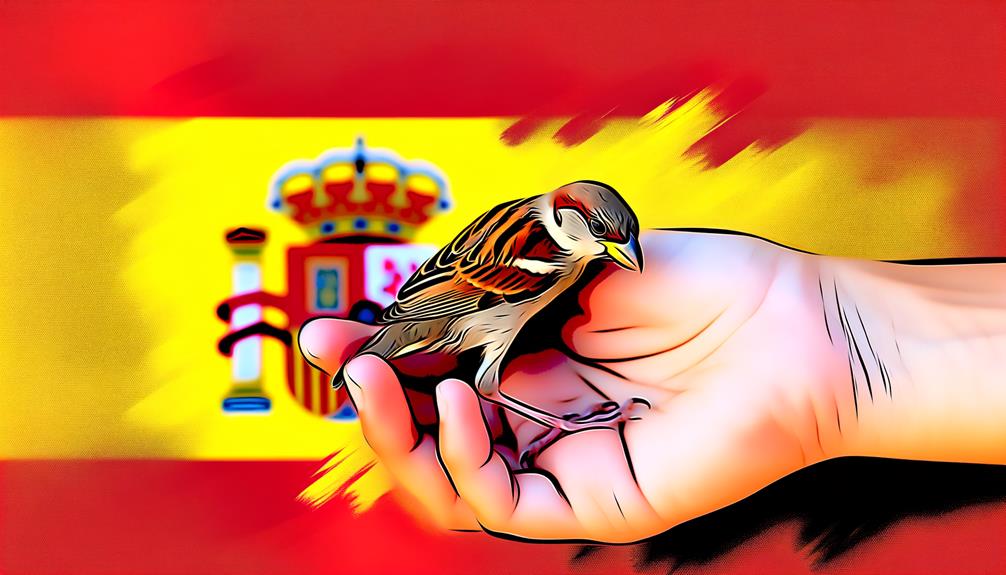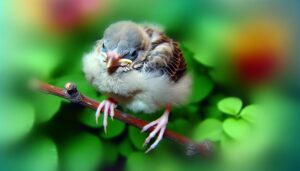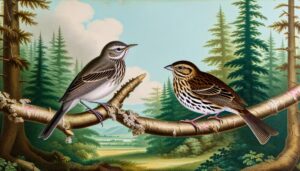How Do You Say Sparrow in Spanish?
In Spanish, the word for 'sparrow' is 'gorrión.' This translation not only signifies a bird species but also highlights the cultural lens through which Spanish speakers perceive this creature. Understandably, accurate translations require a keen grasp of both linguistics and their cultural contexts.
Digging further into this topic also reveals the richness of bird names in Spanish, the cultural importance of sparrows in Spain, and their role in Latin American folklore. Exploring even deeper shows how birdwatching, known as 'pajarería,' can enhance one's Spanish vocabulary and understanding of biodiversity.

Key Takeaways
- 'Sparrow' translates to 'gorrión' in Spanish, reflecting the bird's cultural significance.
- Bird names in Spanish, like 'gorrión', represent the biodiversity in Spanish-speaking regions.
- Sparrows, or 'gorrión', symbolize joy, renewal, and positivity in Spanish culture.
- In Latin American folklore, sparrows also represent simplicity and industriousness.
- Birdwatching, or 'pajarería', can aid in learning Spanish and understanding its ecological and cultural context.
Translating 'Sparrow' Into Spanish
In the field of linguistics, translating the word 'sparrow' into Spanish requires an understanding of both languages, resulting in the Spanish equivalent 'gorrión'. This process isn't as simple as substituting one word for another. It necessitates a comprehension of the cultural, ecological, and ornithological nuances that each language encapsulates.
The term 'gorrión' isn't just a literal translation, it's a reflection of how Spanish culture perceives the bird. It's a small, common bird, often seen in urban areas, hence the Spanish language has a specific term for it. Moreover, this translation underscores the importance of context in linguistics.
Hence, the process of translating 'sparrow' into 'gorrión' is more than a linguistic exercise; it's a cultural exploration.
Understanding Bird Names in Spanish
Exploring the world of avian nomenclature in Spanish offers a fascinating insight into the language's rich biodiversity, cultural nuances, and its people's profound connection with nature.
Bird names in Spanish often reflect regional dialects, embodying the diverse environments and unique species found across the Spanish-speaking world. For example, a sparrow is called 'gorrión' in Spain, a term derived from its characteristic chirping sound. Elsewhere, the bird may bear different names, highlighting the influence of local ecosystems on language.
In understanding these names, one can appreciate the distinctiveness of Spanish fauna and the language's capacity to capture it. This understanding deepens one's grasp of the language, adding a dimension of ecological literacy to linguistic proficiency.
Cultural Significance of Sparrows in Spain
Sparrows, known as 'gorrión' in Spain, hold a distinct place in Spanish culture and folklore due to their ubiquitous presence and unique characteristics. They're often symbolized as carriers of joy, exemplifying the Spanish spirit of 'alegría'.
Their chirping, viewed as a harbinger of spring, is associated with renewal and positivity. They're also featured in local idioms, like 'Cada gorrión a su espiga', which translates to 'Each sparrow to its spike', meaning everyone should stick to their own kind.
They're pivotal characters in traditional children's songs and folk tales, reinforcing their cultural eminence. The humble sparrow, beyond its ornithological significance, encapsulates elements of Spanish heritage, language, and ethos, thus rendering it a cultural icon.
Sparrows in Latin American Folklore
While the cultural resonance of the 'gorrión' extends beyond Spain, it's worth noting that Latin American folklore also weaves intricate tales around these birds.
In many indigenous cultures, sparrows symbolize simplicity, industriousness, and commonality. As small, unassuming creatures, they're frequently depicted as humble messengers or guides, often playing pivotal roles in folk tales and morality stories.
In Mexico's oral tradition, for instance, the 'gorrión' is seen as a harbinger of good news or a spirit guide for the lost. Similarly, Andean folklore often presents the sparrow as an embodiment of endurance and resilience.
These cultural narratives underscore the sparrow's enduring presence in Latin American societies, attesting to its enduring influence and symbolic power.
Learning Spanish Through Birdwatching
Birdwatching, or 'pajarería' in Spanish, can serve as an engaging and effective method for language learners to expand their vocabulary and cultural knowledge, particularly when it comes to learning about birds like the 'gorrión' or sparrow. Observing birds in their natural habitats while learning their names in Spanish bridges the gap between language and nature, providing a unique educational experience.
Here's a simple table to get started:
| English Name | Spanish Name | Bird's Description |
|---|---|---|
| Sparrow | Gorrión | Small, brown and grey, often with streaking |
| Owl | Búho | Large, round eyes, known for nocturnal habits |
| Hummingbird | Colibrí | Tiny, rapid wing beats, attracted to nectar |
This method not only improves vocabulary, but also fosters a deeper connection with the Spanish-speaking world's rich biodiversity.
Conclusion
To sum up, the tiny yet tenacious bird we call a sparrow is known as 'gorrión' in Spanish. This name has deep roots in Spanish and Latin American cultures, often used in folklore and idiomatic expressions.
For instance, a Spanish learner might stumble upon the phrase 'más vale ser cabeza de ratón que cola de león,' which employs 'gorrión' symbolically.
Learning Spanish through birdwatching, such as identifying a 'gorrión', can offer a unique and engaging linguistic experience.





